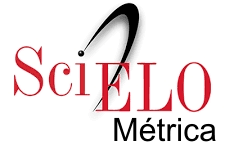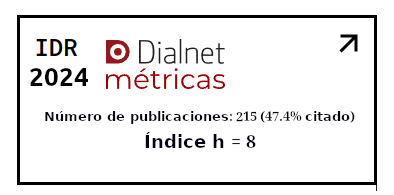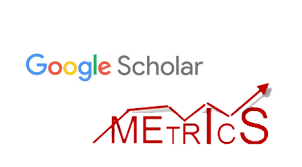Adaptación de la Escala de Creencias de Autoeficacia Docente en estudiantes universitarios chilenos
Palabras clave:
Creencias de autoeficacia, educación superior, análisis factorial confirmatorio (AFC), validez convergente, validez discriminanteResumen
El objetivo del estudio es evaluar la estructura factorial, fiabilidad y validez de la versión abreviada en inglés de la escala de creencias de autoeficacia docente, en una muestra de estudiantes chilenos de pedagogía en inglés de primer, tercer y quinto año de la carrera. Los participantes fueron 309 estudiantes de tres universidades chilenas. El ajuste del modelo de medida se evaluó mediante análisis factorial confirmatorio (AFC). La fiabilidad se estimó a través del coeficiente de fiabilidad compuesta. La validez convergente y discriminante fueron evaluadas mediante el cálculo de la varianza media extraída (VME) y de la √VME. Se utilizó el análisis factorial confirmatorio multi-grupo (AFCM) para evaluar la invarianza del modelo de medida. Los resultados apoyaron una estructura factorial de tres factores, con adecuados niveles de fiabilidad y validez. Estos hallazgos sugieren que el uso de la versión abreviada de la escala cuenta con propiedades psicométricas adecuadas para medir la autoeficacia docente en estudiantes chilenos de pedagogía en inglés.
Descargas
Citas
Acevedo Álvarez, R., y Fernández Díaz, M. J. (2004). La percepción de los estudiantes universitarios en la medida de la competencia docente: Validación de una escala. Revista Educación, 28(2),154-166. Recuperado de https://www.redalyc.org/articulo.oa?id=440/44028208
Aldás, J. (2000). Problemas metodológicos de la evaluación de los modelos de exposición: especial referencia al caso español. En J. Bigné, Temas de planificación de medios. Madrid: Esic.
Ashton, P., Buhr, D. y Crocker, L. (1984). Teachers’ sense of efficacy: a self- or norm-referenced construct? Florida Journal of Educational Research, 26(1), 29-41.
Bandura, A. (1997). Self-efficacy: The exercise of control. New York: Freeman.
Brouwers, A., y Tomic, W. (2000). A longitudinal study of teacher burnout and perceived self-efficacy in classroom management. Teaching and Teacher Education, 16(2), 239-253. https://doi.org/10.1016/S0742-051X(99)00057-8
Burgueño, R., Sicilia, A., Medina-Casaubón, J., Alacaraz-Ibáñez, M., y Lirola, M. J. (2018). Psychometry of the Teacher's Sense of Efficacy Scale in Spanish Teachers' Education. The Journal of Experimental Education, 87:1, 89-100. https://doi.org/10.1080/00220973.2018.1423542
Çapa, Y., Çakıroğlu, J., y Sarıkaya, H. (2005). The development and validation of a Turkish version of teachers’ sense of efficacy scale. Eğitim ve Bilim, 30, 74-81.
Covarrubias, C. G., y Mendoza Lira, M. (2015). Sentimiento de autoeficacia en una muestra de profesores chilenos desde las perspectivas de género y experiencia. Estudios pedagógicos (Valdivia), 41(1), 63-78. https://doi.org/10.4067/S0718-07052015000100004
Covarrubias-Apablaza, C. G., y Mendoza-Lira, M. C. (2016). Adaptación y validación del cuestionario sentimiento de autoeficacia en una muestra de profesores chilenos. Universitas Psychologica, 15(2), 97-108. https://doi.org/10.11144/Javeriana.upsy15-2.avcs
Curran, P. J., West, S., y Finch, J. F. (1996). The robustness of test statistics to nonnormality and specification error in confirmatory factor analysis. Psychological Methods, 1(1), 16-29. https://doi.org/10.1037//1082-989X.1.1.16
Chang, M. L., y Engelhard, G. (2016). Examining the Teachers’ Sense of Efficacy Scale at the item level with rasch measurement model. Journal of Psychoeducational Assessment, 34(2), 177-191. https://doi.org/10.1177/0734282915593835
Cheung, W., y Rensvold, R. (2002). Evaluating Goodness-of-Fit indexes for testing measurement invariance. Structural Equation Modeling: A Multidisciplinary Journal, 9(2), 233-255. https://doi.org/10.1207/S15328007SEM0902_5
Cisneros-Cohernour, E. (2008). Una propuesta interpretativa para la evaluación de la enseñanza en educación superior. Revista Electrónica de Investigación Educativa, Especial. Recuperado de http://redie.uabc.mx/NumEsp1/contenido-cisneros.html
Duffin, L., French, B., y Patrick, H. (2012). The Teachers' Sense of Efficacy Scale: Confirming the factor structure with beginning pre-service teachers. Teaching and Teacher Education, 28(6), 827-834. https://doi.org/10.1016/j.tate.2012.03.004
Egido Gálvez, I., López-Martín, E., Manso, J., y Valle, J.M. (2018). Determining factors of teachers’ self-efficacy in countries of the European Union. Results from TALIS 2013. Educación XX1, 21(2), 225-248. https://doi.org//10.5944/educXX1.15875
Fernet, C., Guay, F., Senécal, C., y Austin, S. (2012). Predicting intraindividual changes in teacher burnout: The role of perceived school environment and motivational factors. Teaching and Teacher Education, 28(4), 514-525. https://doi.org/10.1016/j.tate.2011.11.013
Fives, H., y Buehl, M. (2010). Examining the factor structure of the teachers’ sense of efficacy scale. The Journal of Experimental Education, 78, 118-134. https://doi.org/10.1080/00220970903224461
Fornell, C., y Larcker, D. F. (1981). Evaluating structural equations models with unobservable variables and measurement error. Journal of Marketing Research, 18, 39-50. https://doi.org/10.2307/3151312
García Garduño, J. M. (2000). Las dimensiones de la efectividad docente, validez y confiabilidad de los cuestionarios de evaluación de la docencia: Síntesis de investigación internacional. En Mario Rueda y Frida Díaz-Barriga (compiladores), Evaluación de la docencia (pp. 41-62). México: Paidós.
Gibson, S., y Dembo, M. H. (1984). Teacher efficacy: A construct validation. Journal of Educational Psychology, 76(4), 569-582. https://doi.org/10.1037/0022-0663.76.4.569
Guo, Y., Piasta, S. B., Justice, L. M., y Kaderavek, J. (2010). Relations among preschool teachers' self-efficacy, classroom quality, and children's language and literacy gains. Teaching and Teacher Education, 26(4), 1094-1103. https://doi.org/10.1016/j.tate.2009.11.005
Hair, J., Black, W., Babin, B., Anderson, R., y Tatham, R. (2006). Multivariate data analysis (6th ed.). Uppersaddle River, N.J.: Pearson Prentice Hall.
Hernández Jácquez, L. F., y Ceniceros Cázares, D. I. (2018). Autoeficacia docente y desempeño docente, ¿una relación entre variables?. Innovación educativa (México, DF), 18(78), 171-192. Recuperado de http://www.scielo.org.mx/scielo.php?script=sci_arttext&pid=S1665-26732018000300171&lng=es&tlng=es
Hernández, R., Fernández, C., y Baptista, P. (2003). Metodología de la investigación. México: McGraw-Hill.
Hu, L., y Bentler, P. M. (1999). Cutoff criteria for fit indexes in covariance structure analysis: Conventional criteria versus new alternatives. Structural Equation Modeling: A Multidisciplinary Journal, 6(1), 1-55. https://doi.org/10.1080/10705519909540118
Khairani, A., y Razak, N. (2012). An analysis of the teachers’ sense of efficacy scale within the malaysian context using the rasch measurement model. Procedia - Social and Behavioral Sciences, 69, 2137-2142. https://doi.org/10.1016/j.sbspro.2012.12.178
Klassen, R. M., Bong, M., Usher, E. L., Chong, W. H., Huan, V. S., Wong, I., y Georgiou, T. (2009). Exploring the validity of a teachers’ self-efficacy scale in five countries. Contemporary Educational Psychology, 34, 67-76. https://doi.org/10.1016/j.cedpsych.2008.08.001
Koniewski, M. (2018). The Teacher Self-Efficacy Scale (TSES) factorial structure evidence review and new evidence from Polish-speaking samples. European Journal of Psychological Assessment. Advance online publication. https://doi.org/10.1027/1015-5759/a000475
Lauermann, F., y König, J. (2016). Teachers’ professional competence and wellbeing: Understanding the links between general pedagogical knowledge, self-efficacy and burnout. Learning and Instruction, 45, 9-19. https://doi.org/10.1016/j.learninstruc.2016.06.006
Marsh, H. W. (1984). Students’ evaluations of university teaching: Dimensionality, reliability, validity, potential baises, and utility. Journal of Educational Psychology, 76(5), 707–754. https://doi.org/10.1037/0022-0663.76.5.707
Martínez, J. (2013). Combinación de mediciones de la práctica y el desempeño docente: Consideraciones técnicas y conceptuales para la evaluación docente. Pensamiento Educativo Revista de Investigación Educacional Latinoamericana, 50(1), 4-20. https://doi.org/10.7764/PEL.50.1.2013.2
Mojavezi, A., y Tamiz, M. (2012). The impact of teacher self-efficacy on the students’ motivation and achievement. Theory and Practice in Language Studies, 2(3), 483-491. https://doi.org/10.4304/tpls.2.3.483-491
Muthén, L. K., y Muthén, B. O. (2012). Mplus user’s guide: statistical analysis with latent variables (7th ed.). Los Angeles, CA: Muthén & Muthén.
Nie, Y., Lau, S., y Liau, A. (2012). The teacher efficacy scale: A reliability and validity study. The Asia-Pacific Education Researcher, 21(2), 414-421.
Ozcal, N. (2014). Sense of professional self-efficacy beliefs and learner autonomy support behaviour of middle school teachers. Anthropologist, 18(2), 575-581.
Pan, Y. (2014). Relationships among teachers’ self-efficacy and students’ motivation, atmosphere, and satisfaction in physical education. Journal of Teaching in Physical Education, 33, 68-92. https://doi.org/10.1123/jtpe.2013-0069
Polou, M. (2007). Personal teaching efficacy and its sources: Student teachers’ perceptions. Educational Psychology, 27(2), 191-218. https://doi.org/10.1080/01443410601066693
Rodríguez, S., Regueiro, B., Blas, R., Valle, A., Piñeiro, I., y Cerezo, R. (2014). Teacher self-efficacy and its relationship with students’ affective and motivational variables in higher education. European Journal of Education and Psychology, 7(2), 107-120. https://doi.org/10.1989/ejep.v7i2.183
Schiefele, U., y Schaffner, E. (2015). Teacher interests, mastery goals, and self-efficacy as predictors of instructional practices and student motivation. Contemporary Educational Psychology, 42, 159-171. https://doi.org/10.1016/j.cedpsych.2015.06.005
Schwarzer, R., y Hallum, S. (2008). Perceived teacher self-efficacy as a predictor of job stress and burnout: Mediation analyses. International Association of Applied Psychology, 57, 152-171. https://doi.org/10.1111/j.1464-0597.2008.00359.x
Skaalvik, E., y Skaalvik, S. (2014). Teacher self-efficacy and perceived autonomy: relations with teacher engagement, job satisfaction, and emotional exhaustion. Teaching and Teacher Education, 26(4), 1059-1069. https://doi.org/10.2466/14.02.PR0.114k14w0
Tabachnick, B. G., & Fidell, L. S (2013). Using multivariate statistics (6th ed.). Boston, MA: Pearson.
Tschannen-Moran, M., y MacFarlane, B. (2011). Teacher self-efficacy in the English language arts classroom. In Lapp, D., & Fisher, D., (Eds), Handbook of research on the teaching of the English language arts. 3rd. ed. New York: Routledge.
Tschannen-Moran, M., y Woolfolk Hoy, A. (2001). Teacher efficacy: Capturing an elusive construct. Teaching and Teacher Education, 17(7), 783-805. https://doi.org/10.1016/S0742-051X(01)00036-1
Tsigilis, N., Koustelios, A., y Grammatikopoulos, V. (2010). Psychometric properties of the teachers’ sense of efficacy scale within the greek educational context. Journal of Psychoeducational Assessment, 28(2), 153-162. https://doi.org/10.1177/0734282909342532
Vila, N., Küster, I., y Aldás, J. (2000). Desarrollo y validación de escalas de medida en marketing. Quaderns de Treball: Facultat d’Economia Universitat de Valencia. 104.
Vizcaino, A. E., López, K., y Klimenko, O. (2018). Creencias de autoeficacia y desempeño docente de profesores universitarios. Katharsis, (25), 74-93. Recuperado de http://revistas.iue.edu.co/revistasiue/index.php/katharsis/article/view/997
Wang, H., Hall, N., y Rahimi, S. (2015). Self-efficacy and causal attributions in teachers: Effects on burnout, job satisfaction, illness, and quitting intentions. Teaching and Teacher Education, 47, 120-130. https://doi.org/10.1016/j.tate.2014.12.005
Woolfolk Hoy, A., y Murphy, P. K. (2001). Teaching educational psychology to the implicit mind. In B. Torff & R. J. Sternberg (Eds.), The educational pscyhology series. Understanding and teaching the intuitive mind: Student and teacher learning (p. 145–185). Lawrence Erlbaum Associates Publishers.
Zai, S. A., y Munshi, P. (2016). Construct validity to examine the latent traits of teacher self-efficacy instrument. Advances in Social Sciences Research Journal, 3(4), 74-83. https://doi.org/10.14738/assrj.34.1944
Zee, M., de Jong, P., y Koomen, H. (2016). Teachers’ self-efficacy in relation to individual students with a variety of social–emotional behaviors: A multilevel investigation. Journal of Educational Psychology, 108(7), 1013-1027. https://doi.org/10.1037/edu0000106
Publicado
Cómo citar
Número
Sección
Licencia
Derechos de autor 2020 ACADEMO Revista de Investigación en Ciencias Sociales y Humanidades

Esta obra está bajo una licencia internacional Creative Commons Atribución 4.0.









